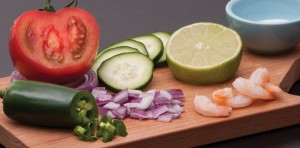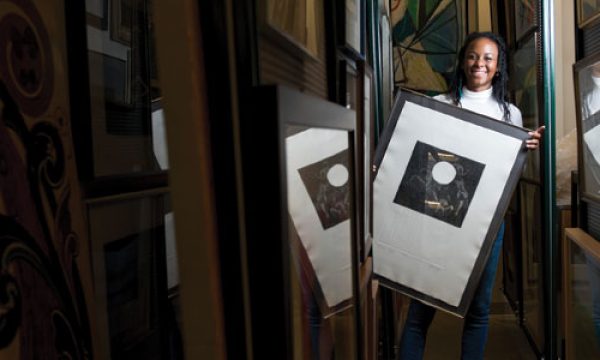 Ceviche is a South and Central American favorite that’s also been popularized in the United States. It’s a bright and flavorful seafood dish that’s not raw, but it’s not exactly cooked either. In fact, it’s never exposed to heat.
Ceviche is a South and Central American favorite that’s also been popularized in the United States. It’s a bright and flavorful seafood dish that’s not raw, but it’s not exactly cooked either. In fact, it’s never exposed to heat.
Although it’s not cooked in the traditional sense, the raw fish in ceviche goes through a chemical process that rearranges or “denatures” its proteins, much like what happens when meat or other protein is cooked with heat. The acid in citrus juice cures the raw fish, which makes it safer to eat.
This is just one of the fascinating processes students learn in one of Augsburg College’s popular physics courses: The Science of Food and Cooking, taught by Associate Professor Ben Stottrup.
Among other concepts, students in the course learn the fundamental physics and chemistry of materials science through hands-on preparation, like the phase change that occurs when spinning cotton candy and the Maillard reaction caused by searing a steak. They are taught the mechanical properties of ricotta cheese and the states of matter in a root beer float.
And the students love experimenting with various cuisine.
“My biggest takeaway from this class is that science is, in fact, present in everything in our daily lives,” said Cynthia Del Villar ’15, business administration and economics major. “Even eating is a daily reminder that food undergoes its own scientific transformation through cooking or even combining certain ingredients, like oil and vinegar.”
Del Villar took much away from the class—from learning how to prevent freezer burn to emulsifying a mayonnaise to gaining an understanding of heat transfer through a molten chocolate cake. But she also made a personal contribution to the course— her Mexican family’s traditional shrimp ceviche recipe for experimentation in the lab.
Restaurant reviews, cook-offs, and potlucks
But it’s not just the food that gets students engaged—Stottrup also introduces competition and community involvement. For example, while baking cupcakes, some groups are allowed the use of measuring devices while others are not. Or some use measurements based upon volume versus weight. This, of course, determines the outcome of each recipe.
At the end of each lab, guest judges from various departments on campus decide whose dish was most successful. The competition and participation of the wider campus community “creates an educational, memorable, and interactive experience,” Stottrup said.
Members of the greater Twin Cities restaurant scene also play an important role in the class. One requirement of the course is that students dine at one of three well-known Minneapolis restaurants and then write a restaurant review describing the materials science on their plate. Afterward, one chef from each restaurant comes to campus to participate in a panel discussion on the creativity and lifestyle of being a chef.*
Community members participate in these panel discussions each term, which range from local cooks revealing the process of handcrafting the perfect scoop of natural, organic ice cream to urban planners explaining sustainable food systems to entrepreneurs from the craft beer industry talking about the chemistry of brewing.
To wrap up the semester, the class participates in a “Minnesota potluck,” where each student makes a dish to share and describes the science behind it to their peers. These engaging, communal activities make science “fun and accessible to all students, not just science majors,” Stottrup said. He hopes the class helps students gain a new appreciation for science, as well as “for growing, preparing, cooking, and simply enjoying food.”
*SPECIAL THANKS to chefs Erick Harcey of Victory 44, Landon Schoenefeld of Haute Dish, and Karyn Tomlinson of Borough for lending their expertise to the course.
Shrimp ceviche for a crowd
“ This is a traditional family recipe from my parents’ home state of Nayarit, on Mexico’s west coast.”
– Cynthia Del Villar ’15
Ingredients:
• 4 pounds headless shrimp
• 10 medium limes
•10 medium tomatoes
• 4 large cucumbers
• 1 purple onion
• 8 small green serrano chili peppers
• 2 tablespoons salt
• Tortilla chips
Preparation:
- Cleanse shrimp in water, peel completely, and chop into half-inch pieces. Place in large bowl and set aside.
- In a blender, combine lime juice and serrano chili peppers and blend until smooth. Pour over shrimp.
- Add 2 tablespoons of salt to mixture and stir.
- Cut onion into thin slices and add to shrimp. Allow mixture to sit for 20 minutes.
- In the meantime, dice tomatoes and cucumbers into small cubes and add to shrimp.
- Mix all ingredients well and salt to taste.
- Serve with chips or tostadas.




